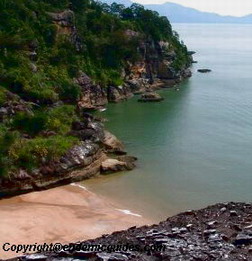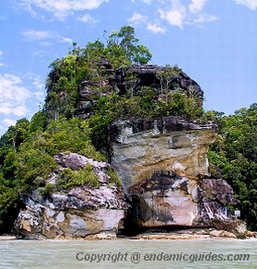|
Welcome To
BAKO NATIONAL
PARK PAGE - SARAWAK
|
Introduction and history
The constant erosion over millions of years has turned Bako
into a picturesque coastline of steep cliffs, rocky headlands
and many stretches of sandy bays and coves. The erosion caused
by constant waves at the base of cliffs has carved sea arches
and sea stacks. Beautiful sandstone formations featuring pink
and iron patterns on cliff faces can be seen along most of the
coastline.
Declared a protected area on May 1st, 1957, Bako
is Sarawak's oldest national park covering an area of 2,727
hectares at the tip of the Muara Tebas peninsula. It is one of
the smallest national parks in Sarawak, yet one of the most
interesting as it contains almost every type of vegetation found
on Borneo Island along with a rich variety of wildlife.
With a well maintained network of trails, Bako National Park
has something for everyone. Experience this unique
environment through anything from easy day hikes to tough
multi-day jungle treks!

Flora and Fauna
Bako contains an incredible variety of plant species and
vegetation types that add natural wonder of the park.
While visiting Bako, it is possible to see up to 25 distinct
types of vegetation from seven different eco-systems.
These eco-systems include: Beach Vegetation, Cliff Vegetation,
Kerangas or Heath Forest, Mangrove Forest, Mixed Dipterocarp
Forest, Padang or Grasslands Vegetation, and Peat Swamp Forest.
It is easy to explore these eco-systems via the jungle trails
and take-in the different colors, shapes and sounds. Start your
exploration at the Park Office in Telok Assam to get a sneak
preview! Surprises are found around every bend such as
strange carnivorous plants including pitcher plants, sundews,
and bladderworts.
With its long history as a protected area, Bako is a
wildlife hotspot. Visitors, especially those who stay
overnight, have countless opportunities to observe and
photograph wildlife.

Bako is home to approximately 150 rare proboscis monkeys,
found only in Borneo. They are mostly arboreal (tree-dwelling),
moving about the forest or mangroves in small groups and feeding
on young leaves, shoots, sour fruits and seeds. The
largest mammal found in Bako is the Bornean Bearded Pig. As its
name implies, it is distinguished from other wild pigs by
prominent bristles on either side of its snout. A number of
lizards and snakes are also found at Bako, most of which are
harmless. Bako is also a fascinating place for bird watching.
The nocturnal creatures in Bako include the flying lemur,
pangolin, mouse deer, various bats, tarsier, slow loris and palm
civet. Day or night, the jungle is full of life.

Attraction and Activities
Bird
watching
Bird watchers have recorded over 150 bird species in Bako
including two types of Hornbills, the state bird of Sarawak. In
addition to the residents of the region, Bako is also a
fantastic place for observing migrant birds.
Treks and
Trails
Bako's extensive trail system is made up of 16 colour-coded
jungle trails, which offer a range of walking and hiking
options. The fit and adventurous can opt for full-day jungle
hikes or overnight camping expeditions, while those who prefer
to take it easy can opt for a relaxing forest walk.
Teluk Assam
Teluk Assam is near the Park Office and is a great place for
spotting wildlife. Long-tailed macaques, silver leaf monkeys,
common monitor lizards, plantain squirrel, bearded pigs and
mouse deer are all found here. Telok Assam is also an excellent
bird watching location.
Tanjung
Sapi
A short but steep climb through cliff vegetation, it takes
about 30 minutes to reach Tanjung Sapi. You will be rewarded
with excellent views of Telok Assam, the South China Sea and
Santubong!
Tanjung Rhu
From the Park Office, it takes about two and a half hours or
45 minutes from the Tajor junction to reach Tanjung Rhu. This
trail branches off the Tajor trail and leads across open country
to the rocky peninsula and a small headland where you can see a
wave-cut natural platform and natural rock pools.
More on Page 2 >>
Package Tour to Bako National Park
|